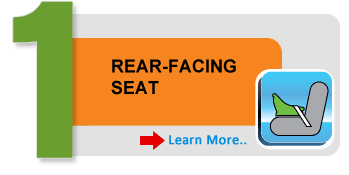Car Seat Safety.
"Vermont's Child Passenger Safety Program is designed to draw attention to the importance of child safety seats and to help parents understand the 4 Stages of Seat Safety that every child progresses through."
Source for all information: BeSeatSmart.org

Stage 1: Rear-Facing
For the best possible protection, keep infants and young toddlers in the back seat, in a rear-facing child safety seat, as long as possible up to the height or weight limit of the particular seat.
Stage 3: Booster
Once children outgrow their forward-facing seat, they should ridein booster seats, in the back seat, until vehicle seat belts fit properly.
Stage 2: Front-Facing
Children may ride in forward-facing child safety seats, in the back seat, until they reach the upper weight or height limit of the seat.
Stage 4: Seat Belt
When children outgrow their booster seats, they can use the adult seat belt in the back seat if it fits properly.
Car Seat History
There’s nothing more important than keeping our children safe. Although every year children are injured or killed in car crashes, proper use of child safety seats can help keep our children safe. As a parent, you may find it difficult to sort out conflicting or confusing car safety seat information as your child develops and grows. Child safety seats work best when used correctly. But how do you know what’s correct?
Specific Cases
Information for Used Child Restraints:
How do you know if a used seat is okay to use? Here are some questions to ask yourself:
-
Do I know the history of the seat? A seat that comes from a best friend or family member is a very different thing than a seat that is purchased at a garage sale – the history of the seat is available. If the history of the seat is unknown, do not use it.
-
Has the seat ever been in a crash? If it has, discard and do not use.
-
Is the seat within its expiration date? (Usually 6 years from date of manufacture – check your owner’s manual for information on your seat.) If it’s not, it’s time for a new seat.
-
Does the seat have all of its parts? The owner’s manual will have a listing of all parts. If you are missing any and can pass the first three steps, call the manufacturer for replacement parts.
Remember, you are, TRUSTING this seat with the LIFE OF YOUR CHILD!
If in doubt, swap it out! Call 888-VMT-SEAT for help!
Information for Expired Child Restraints:
Be sure to check the expiration date of your child restraints. Sometimes expired seats are seen at our fitting stations and inspections. Some people don't realize the importance of the expiration dates of child restraints. DO NOT USE an expired car seat.
Car seats live in extreme environments, the very hot and very cold temperature fluctuations of a car through out the seasons. These temperature swings cause the plastic, over time, to become brittle and fail which can cause the harness to pull through the shell of the car seat and eject the child. You might not be able to visually see the material weakness, but manufacturers' test their materials and products for safety. Manufacturers' expiration dates are there for a reason. If your car seat is expired, STOP! DO NOT USE IT. Call 888-VMT-SEAT for help.
Child Restraint Re-use After Minor Crashes:
NHTSA Position
-
NHTSA recommends that child safety seats be replaced following a moderate or severe crash in order to ensure a continued high level of crash protection for child passengers.
-
NHTSA recommends that child safety seats do not automatically need to be replaced following a minor crash.
-
Minor crashes are those that meet ALL of the following criteria:
-
The vehicle was able to be driven away from the crash site;
-
The vehicle door nearest the safety seat was undamaged;
-
There were no injuries to any of the vehicle occupants;
-
The air bags (if present) did not deploy; AND
-
There is no visible damage to the safety seat
-




